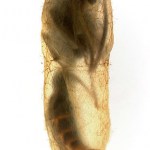Science
The Steinmetz Symposium is today at Union, as mentioned in yesterday's silly poll about fears (I love the fact that "Wavefunction Collapse" leads "Monsters from the Id" by one vote at the time of this writing-- my readers are awesome). As a more serious follow-up, there were two presentation options offered to the students, and this year's physics majors overwhelmingly chose one over the other. I'm curious as to how many people would make the same choice, so here's a poll:
You have to give a presentation about a research project you have done. Which of these presentation types would you…
Image: wemidji (Jacques Marcoux).
Nam et ipsa scientia potestas est (And thus knowledge itself is power)
-- Sir Francis Bacon.
This week's edition of Scientia Pro Publica (Science for the People); "Scientia Pro Publica 28" was published this past Monday by Kelsey at her blog, Mauka to Makai. This nicely-done issue of Scientia filled with well-written and thought-provoking essays about a variety of topics.
After you've read this carnival, I hope you will submit your blog essays to the next issue of Scientia. We are trying an experiment right now: we are trying to publish this blog…
There's a minor kerfuffle at the moment over the XENON experiment's early data (arxiv paper) which did not detect any dark matter in 11 days of data acquisition. This conflicts with earlier claims by the DAMA experiment and recent maybe-kinda-sorta detections by the CoGeNT and CDMA experiments.
As a result, a couple of members of other collaborations have posted a response on the arxiv saying, basically, that they don't believe the sensitivity claimed for the XENON detector in the energy range in question, and that their result can't really be said to rule out the possibility of dark matter…
My publisher would like to include a Teacher's Guide with the paperback edition of How to Teach Physics to Your Dog. which means that, well, I need to put together a Teacher's Guide for How to Teach Physics to Your Dog. The problem is, I'm not exactly sure what should go in that sort of thing.
So, if you have any opinions on the subject of Teacher's Guides for pop-science books in general, or can point to examples of Teacher's Guides that you particularly like, or have suggestions for what ought to be in a Teacher's Guide for How to Teach Physics to Your Dog. If you were a teacher planning to…
Anyone who's been reading this blog for any length of time longer than a few weeks knows what I think of Deepak Chopra. Indeed, he's been a recurring topic here since the very beginning (just type his name into the search box for this blog if you don't believe me). In fact, Chopra has "distinguished" himself by becoming a fairly recurring target on ScienceBlogs in general and a number of skeptical blogs, including SkepChick and NeuroLogica Blog. The reason should be obvious. No one--and I mean no one--lays down the quantum dualistic woo the way that Deepak can. Whether it be abusing genetics…
Via Jerry Coyne, I came across this essay over at the BioLogos website. The author: Steven Benner. The title: The Dangers of Advocacy in Science. The key paragraphs:
This provides another reason why it is easy to be confused about what science is and what scientists do. The imagery of science and scientists is widely expropriated in the public square by non-scientists.
The temptation to participate in the public dialogue as an advocate is considerable. I myself have been interviewed by reporters who become impatient if I actually practice science before their eyes. It is generally simpler…
the collapse of the Deepwater Horizon drilling rig in the Gulf of Mexico is making a mess, but a lot of the numbers being bandied about make little sense
partly the problem is units, with news media freely exchanging barrels per day with gallons per minute and rates with integrals
I am but a humble physicist, but that has never stopped me before...
for real info go someplace like The Oil Drum
So, lets take your benchmark guesstimate as the oft quoted 5000 barrels per day.
Now there's a meaningless unit.
A barrel is a whisker under 160 liters, so per day this is 800,000 liters (massing about…
Over at the Virtuosi, there's a nice discussion of the physics of letting air out of tires. Jesse opens the explanation with:
Have you ever noticed how when you let air out of a bike tire (or, I suppose, a car tire) it feels rather cold? Today we're going to explore why that is, and just how cold it is. Many people consider the air escaping from a tire as a classic example of an adiabatic process. What is an adiabatic process? It is a process that happens so quickly there is no time for heat flow to occur. For our air in the bike tire this means we're letting it out of the tire so…
It's been a couple of weeks since I did an update on How to Teach Physics to Your Dog, but that's been as much laziness as a lack of news. Some developments, mostly relating to foreign lands:
The US paperback edition is slated for December release. I'm working on a Teacher's Guide to go with it-- suggestions on what ought to be in there are welcome, as I have no idea
If you do the right search, you'll also find a forthcoming UK edition which will be out this fall with a slightly different title. There's a production schedule for this, and everything-- more information as things become…
From the "I-never-thought-I'd-use-this-class" file, I took a semester course once from an oil spill expert. Professor Ed Gilfillan had studied the response of Prince William Sound to various clean-up regimens following the wreck of the Exxon Valdez, and we spent weeks learning about chemistry of oil spills and the factors involved in ecological recovery. The class was over 15 years ago, mind you, and in retrospect I remember only two things.
But these are two very key things, and they are both relevant to the ongoing tragedy in the Gulf of Mexico.
1. The soil structure at the coastline will…
tags: education, public outreach, SciCafe, science cafe, AMNH, American Museum of Natural History, NYC, streaming video
Who: AMNH paleontologists Dr Mike Novacek and Dr Mark Norell
What: free public presentation for kids of all ages, "Travels with Tyrannosaurus"
When: tonight, 5 May at 700pm
Where: Gottesman Hall of Planet Earth, American Museum of Natural History, Enter at the 81st Street (Rose Center) [directions and maps]
Cost: FREE, and there is a cash bar too! (must be 21+ with ID to purchase alcohol)
Amazing fossils are still out there, waiting to be discovered. Museum…
Image: wemidji (Jacques Marcoux).
Nam et ipsa scientia potestas est (And thus knowledge itself is power)
-- Sir Francis Bacon.
This week's edition of Scientia Pro Publica (Science for the People); "Scientia Pro Publica 28" was published this past Monday by Kelsey at her blog, Mauka to Makai. This nicely-done issue of Scientia filled with well-written and thought-provoking essays about a variety of topics.
After you've read this carnival, I hope you will submit your blog essays to the next issue of Scientia. We are trying an experiment right now: we are trying to publish this blog…
An amazing photo posted this week at Antweb shows a developing male Cerapachys ant inside the silken cocoon:
(Image by Erin Prado)
The discussion is interesting. Sam Harris recently and infamously proposed that, contra Hume, you can derive an 'ought' from an 'is', and that science can therefore provide reasonable guidance towards a moral life. Sean Carroll disagrees at length.
I'm afraid that so far I'm in the Carroll camp. I think Harris is following a provocative and potentially useful track, but I'm not convinced. I think he's right in some of the examples he gives: science can trivially tell you that psychopaths and violent criminals and the pathologies produced by failed states in political and economic collapse are…
So much to read this week! Here are a couple of quick links of interest:
Carl Zimmer on comparing the E. coli genome to Linux code:
A number of scientists have begun to compare natural and manmade networks. A lot of the same rules appear to be at work in the growth of the Internet, airport connections, brain wiring, ecosystem food webs, and gene networks. But very often, scientists are finding, it's the differences between natural and manmade networks that are most revealing, offering clues to the different ways in which people and evolution build complex things.
And the NYT Magazine has an…
Image: wemidji (Jacques Marcoux).
Nam et ipsa scientia potestas est (And thus knowledge itself is power)
-- Sir Francis Bacon.
This week's edition of Scientia Pro Publica (Science for the People); "Scientia Pro Publica 28" has been published by Kelsey at her blog, Mauka to Makai.
After you've read this carnival, perhaps you also wish to submit your blog essays to the next issue of Scientia? If so, you're in luck because we are trying an experiment: we are trying to publish this blog carnival on a weekly basis this spring, so we need enough submissions make this a "go." So I ask you to…
tags: education, public outreach, SciCafe, science cafe, AMNH, American Museum of Natural History, NYC, streaming video
Who: AMNH paleontologists Dr Mike Novacek and Dr Mark Norell
What: free public presentation, "Travels with Tyrannosaurus"
When: Wednesday, 5 May at 700pm
Where: Gottesman Hall of Planet Earth, American Museum of Natural History, Enter at the 81st Street (Rose Center) [directions and maps]
Cost: FREE, and there is a cash bar too! (must be 21+ with ID)
Amazing fossils are still out there, waiting to be discovered. Museum paleontologists Mike Novacek and Mark Norell will…
While I missed the controversial episode with comments about aliens, I figured I should at least take a look at the Discovery Channel's Into the Universe with Stephen Hawking, so I put it on last night after putting SteelyKid to bed. This was the big two-hour "Story of Everything" episode, starting with the Big Bang and describing the whole history of the universe.
I made it through about half an hour, before I gave up and went to bed. This was partly due to it being a really long day (I took SteelyKid shopping and to a playground, did some yard work, and went to a meeting on campus), so I…
Voting has closed on the Laser Smackdown poll, with 772 people recording their opinion on the most amazing of the many things that have been done with lasers in the fifty years since the invention of the first working laser (see the Laserfest web site for more on the history and applications of lasers). The candidates in the traditional suspense-building reverse order:
Lunar laser ranging 22 votes
Cat toy/ dog toy/ laser light show 41 votes
Laser guide stars/ adaptive optics 46 votes
Holography 47 votes
Laser eye surgery 53 votes
Optical storage media (CD/DVD/Blu-Ray) 60 votes
Laser…
With over 700 votes cast in the Laser Smackdown poll in honor of the 50th anniversary of the laser, laser cooling has opened a commanding 20-vote lead in the race to be the Most Amazing Laser Application of All Time. If you prefer one of the other options, you have only six hours left to change the final outcome:
Which of the following is the most amazing application of a laser?Market Research
Voting will remain open until midnight, with the ultimate winner announced on Monday, May 3rd. So get reading, and get voting. One vote per computer per user, please-- this is Serious Science.

